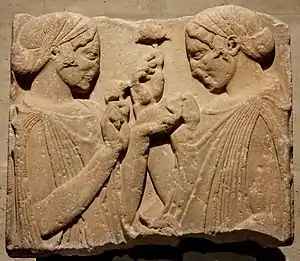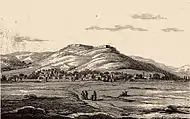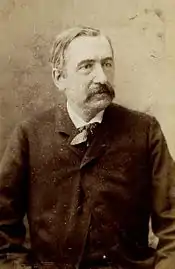The Exaltation of the Flower
The Exaltation of the Flower (L'Exaltation de la Fleur) is the modern title given to an early Classical Greek marble fragment of a funerary stele from the 5th century BC.[1] It was discovered in 1863 by Léon Heuzey and Henri Daumet at a church in Farsala, Thessaly, Greece.[2][3] Carved in bas-relief in the severe style, the extant upper fragment of the marble relief stele depicts two women holding what appear to be flowers or fungi and another object in their hands. The work is held by the Louvre museum in the Department of Greek, Etruscan, and Roman Antiquities.
| The Exaltation of the Flower | |
|---|---|
 | |
| Artist | Unknown Greek artist |
| Year | c. 470–460 BC |
| Type | Parian marble |
| Dimensions | Height: 56.5 cm (22.2 in). Width: 67 cm (26.4 in). Depth: 14 cm (5.5 in). |
| Condition | Fragment |
| Location | Louvre, Paris |
Background
French archaeologist and historian Léon Heuzey began working with the French School at Athens in Greece at the age of 20 in 1851.[4] He made his most famous discovery of that period in the town of Farsala, a city in southern Thessaly.[5] In antiquity, the area was named Pharsalos, and became known for the Battle of Pharsalus in 48 BCE, where Julius Caesar defeated Pompey during the Great Roman Civil War.[6]
Heuzey and the architect Henri Daumet were involved in an official mission to collect objects related to Caesar's campaigns; they also were interested in other artifacts unrelated to their work.[4] In 1863, they found this marble bas-relief embedded in the walls of a church in the neighborhood of Paleo-Loutro in Farsala and named it The Exaltation of the Flower. Heuzey was informed that the stone was originally discovered in a garden, close to another stone that was not recovered. Heuzey purchased the stone and had it sent to the Louvre in Paris.[7][3] Back in France, Heuzy would become curator of the Louvre, where he would retire in 1908.[4]
Description

A precise description and interpretation of the work has remained elusive since its initial discovery in the 19th century. Scholars agree on some aspects and disagree on others.[8] British Greek art scholar Martin Robertson notes that both women can be seen wearing the tubular peplos garment common to the Classical period. According to the descriptive text found in the Atlas database of the exhibited works of art at the Louvre, the women also are wearing a kekryphalos, a hairnet in the Greco-Roman hairstyle, and appear to hold a type of flower, perhaps poppy or pomegranate. One of the women in the stele carries what resembles a bag, presumed to be carrying seeds in the interpretation.[9]
Analysis
In his 1868 paper, Heuzey argued that the images in the stele suggested the goddesses Persephone (Kore) and Demeter, referring to the cult of Kore and the legend of Demeter found in the Homeric Hymns. French archaeologist and art historian Maxime Collignon explained, "Heuzey believes that this monument refers to the cultus of Core, daughter of Demeter, a divinity suggesting in Greek legend the ephemeral but incessantly recurring bloom of nature."[2] French archaeologist Olivier Rayet (1847–1887) disagreed with the interpretation Heuzy offered.[4] While Heuzey's perspective still has adherents, it has largely fallen out of favor among art historians. According to the Perseus Project at Tufts University, "It is now generally agreed ... that the figures represented are mortals rather than goddesses."[8]

German archaeologist Heinrich Brunn believed the decorative qualities of the Pharsalos stele originated in Asia Minor. Following this line of reasoning, Scottish archaeologist Alexander Stuart Murray compared the facial features of the stele, such as the eyes, lips, and nose, to similar facial features found in the Harpy Tomb relief from Xanthos in Lycia.[10] American curator Edward Robinson notes the influence of the Ionic schools on this and other artwork from ancient Aeolia, now known as Thessaly: "It is now a question whether these works were done by local artists under this influence, or by Ionic artists who may have established themselves in Thessaly, as they did in other parts of Greece."[11] The Ionian style's influence also may be seen in the depiction of the hair-net worn by the women in the relief.[12]
French scholar Charles Picard (1883–1965) argued that if the stele fragments were reconstructed,[note 1] the bottom missing fragment would have showed the figure on the left standing and the one on the right seated:[13][14]
Neither can the oblique trend of the drapery, belt-high in the silhouette (in profile) of the elder, be explained … without accepting that she was seated, her left forearm resting on her thigh. Only thus could the dice be handled. Only thus, moreover, can so extreme a slope in the pleats coming away from the shoulder, pleats that would have to fall vertically in a non-seated figure, become understandable. On the right, let it not be readily forgotten that all the pleats turn strongly forward, so that they pass the centerline of the stele, marked by the high, triumphant flower and the mingled group of hands. For the maiden on the left, although the cascade of pleats is generally much more direct—as appropriate to a standing posture—some of them, curiously arched, turn forward as well, for example at the left armhole. They can scarcely be understood without again invoking the supporting effect produced by the leg of the seated woman. The folds of Kore’s sleeve, which in 1939 I drew a little too short in the descent, carry on to Demeter’s lap, where they spread out.[15]
German classical archaeologist Roland Hampe (1908–1981) disagreed with Picard's hypothesis, saying that the size of the stele should demonstrate that both women were standing, not sitting.[13]
Flowers, fungi, or bones
It is generally agreed that the plants depicted in the stele fragment are either poppies or pomegranate flowers,[9] however, classical archaeologists and historians of ancient Greek art discuss different species in the literature: German scholar Ernst Langlotz (1895–1978) thought that the women were holding a type of rose;[13] Picard recognizes the symbolism of Demeter and Kore and identifies the flowers as a species of poppy, possibly the opium poppy, the Oriental poppy, or the Iranian poppy.[15][13] Careful examination of the thick 'stems' fails to resemble that of the flowers. German scholar Eugen Petersen (1837–1919) proposed that the figures were holding knucklebones (talus bones from goats or sheep used to play the game of jacks) in their left hand and roses in the right hand; Hampe argues that the stele depicts only knucklebones, not flowers.[13]
In 1911, Greek scholar and archaeologist Rufus B. Richardson, formerly of the American School of Classical Studies at Athens, observed that what was being described as flowers in the relief, looked similar to mushrooms.[16] English classicist Robert Graves and Italian ethnobotanist Giorgio Samorini both have referred to the fragment as evidence for the entheogen hypothesis, speculating that the significant items depicted in the work are a type of psychoactive mushroom that was used in the Eleusinian Mysteries.[17][18] Graves even featured the image as the cover of one edition of The Greek Myths, noting that although it might be depicted in artwork, it would remain unnamed in texts because of its sacredness. American classicist Carl A. P. Ruck has made similar arguments.[19] Although the entheogen hypothesis is controversial and generally rejected by mainstream scholarship,[note 2] in a review of Hampe's Die Stele aus Pharsalos im Louvre (1951), Picard notes that "one may be increasingly reminded that Pharsalos was indeed an Eleusinian center".[15]
Alternate titles
The work is referred to by many different titles in contemporary literature. These include:
- Adoration of the Flower [20]
- Demeter and Kore Exalting the Flower [21]
- Demeter and Persephone [22]
- The Elevation of the Flower [16]
- Maidens Enjoying Flowers [23]
- Pharsalos Bas-Relief [19]
- Pharsalos relief [10]
- Relief of Demeter and Kore [24]
- Stele of Pharsalos [25]
- Stele of the Two Sisters [26]
- The Uplifting of the Flower [27]
Notes
- A scanned image hosted by the German Archaeological Institute (DAI) and the Archaeological Institute of the University of Cologne extrapolates the reconstruction of the missing bottom fragment. It is available here. For the main object record, see here.
- Samorini (1998) writes: "This bas-relief takes us to the very heart of the 'Eleusinian question,' its mysteries, and the controversial issue of the Eleusinian entheogen’s psychopharmacology. Researchers have recently cast doubts on and rejected the hypothesis put forward by Wasson, Hofmann & Ruck in 1978 that presents ergot and its visionary alkaloids as the psycho-pharmacological key to the Eleusinian Mysteries..."
References
- Lis, Michel; Béatrice Vingtrinier (2009). Flowers in the Louvre. Flammarion. pp. 16–17. ISBN 2081228203. OCLC 501814047.
- Collignon, Maxime; John Henry Wright, trans. (1886). A Manual of Greek Archæology. Cassell Publishing Company. pp. 142–143. OCLC 1380621.
- Heuzey, L. (June 1868). L'exaltation de la fleur, bas-relief grec de style archaïque trouvé à Pharsale Journal des savants. pp. 380–395. ISSN 0021-8103. OCLC 1713951.
- Monceaux, Paul (1922). Éloge funèbre de M. Léon Heuzey, membre de l'Académie. Comptes rendus des séances de l'Académie des Inscriptions et Belles-Lettres. 66 (1): 53–56. ISSN 1969-6663. OCLC 804512263.
- Schwartz, Emmanuel. (2010). Heuzy, Léon. Dictionnaire Critique des Historiens de L'Art. Institut National d'Histoire de l'Art. OCLC 320532175.
- Fields, Nic (2010). Julius Caesar: Leadership, Strategy, Conflict. Osprey Publishing. pp. 23–26. ISBN 9781846039287. OCLC 449845119.
- Heuzey, L.; H. Daumet (1876). Mission archéologique de Macédoine. Volume 1. Paris. pp. 415–417. OCLC 237249471.
- Louvre Ma 701 (Sculpture). Perseus Project. Tufts University. OCLC 557223823.
- Fragment de stèle dit "L'Exaltation de la fleur". Atlas: the database of the exhibited works of art (in French). Musée du Louvre. Retrieved March 25, 2015. OCLC 881834368.
- Murray, Alexander Stuart (1880). A History of Greek Sculpture: From the earliest times down to the age of Pheidias. London: John Murray. pp. 289–291. OCLC 3030573.
- Robinson, Edward (1896). Catalogue of Casts Part III: Greek and Roman Sculpture. Museum of Fine Arts Boston. p. 32. OCLC 83996401.
- Benson, Carol (2001). A Greek Statuette in Egyptian Dress. The Journal of the Walters Art Museum, 59. pp. 9–10. ISSN 2328-3831. OCLC 244293425. (subscription required)
- De Ruyt, Franz. (1952). Roland Hampe, Die Stele aus Pharsalos im Louvre. L'antiquité classique, 21 (2): 544. ISSN 2295-9076.
- Robertson, Martin (1981). A Shorter History of Greek Art. Cambridge University Press. pp. 57–58. ISBN 0521280842. OCLC 6864625.
- Picard, Charles. (1953). Die Stele aus Pharsalos im Louvre by Roland Hampe. Gnomon, 25 (2): 82–85. OCLC 1160828. (subscription required)
- Richardson, Rufus Byam (1911). A History of Greek Sculpture. American Book Company. pp. 73, 96. OCLC 517364.
- Samorini, Giorgio (1998). The Pharsalus Bas-Relief and the Eleusinian Mysteries. The Entheogen Review, 7(2): 60–63. OCLC 26889588.
- Samorini, Giorgio; Gilberto Camilla (1995). Rappresentazioni fungine nell’arte greca. Annali del Museo Civico di Rovereto, 10: 307–326. (html). OCLC 42661455.
- Ruck, Carl A. P. (2006). Sacred Mushrooms: Secrets of Eleusis. Ronin Publishing. p. 49. ISBN 9781579510305. OCLC 65203694.
- Trendall, Arthur Dale (1972). Notes on Greek and Roman Art. University of Melbourne. p. 29.OCLC 1943697.
- Ward, Gerald W. R. (2008). The Grove Encyclopedia of Materials and Techniques in Art. Oxford University Press. p. 570. ISBN 9780195313918. OCLC 475021534.
- Ruether, Rosemary Radford (2006). Goddesses and the Divine Feminine: A Western Religious History. University of California Press. p. 70. ISBN 9780520250055. OCLC 441816393.
- Tominaga, Soichi; Takaaki Matsushita (1970). Discovery of Harmony. Expo Museum of Fine Arts. p. 75. OCLC 135246.
- VIA item: Relief of Demeter and Kore. Visual Information Access. Harvard Library. Harvard University. Retrieved March 22, 2015. OCLC 41022089.
- Paris, Pierre; Jane Ellen Harrison (1890). Manual of Ancient Sculpture. H. Grevel and Company. pp. 244–245. OCLC 3761210.
- Seta, Alessandro della (1914). Religion and Art: A Study in the Evolution of Sculpture, Painting and Architecture. T.F. Unwin. p. 228. OCLC 2756223.
- Vitry, Paul (1922). The Louvre Museum. Morancé. p. 62. OCLC 5434075.
Further reading
- Biesantz, Hagen. (1965). Die thessalischen Grabreliefs. Studien Zur Nordgriechischen Kunst. Mainz: Philip von Zabern. OCLC 164946719.
- Hamiaux, Marianne (1992). Les Sculptures grecques. Des origines à la fin du IVe siècle avant J.-C. Volume I. ISBN 2711826031. OCLC 186538987.
- Hampe, R. (1951). Die Stele aus Pharsalos im Louvre. Berlin: Walter de Gruyter & Co. OCLC 2205559.
- Knauf-Museum (2005). Reliefsammlung der großen Kulturepochen. J.H.Röll Verlag. p. 139. ISBN 3897542404. OCLC 181466502.
External links
- Official site (French)